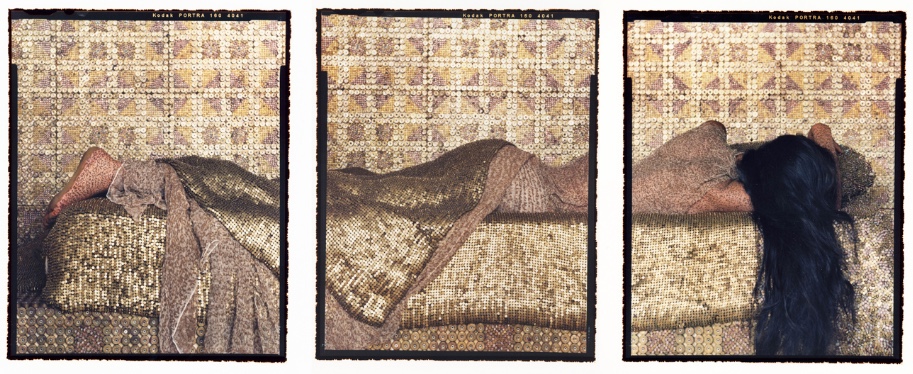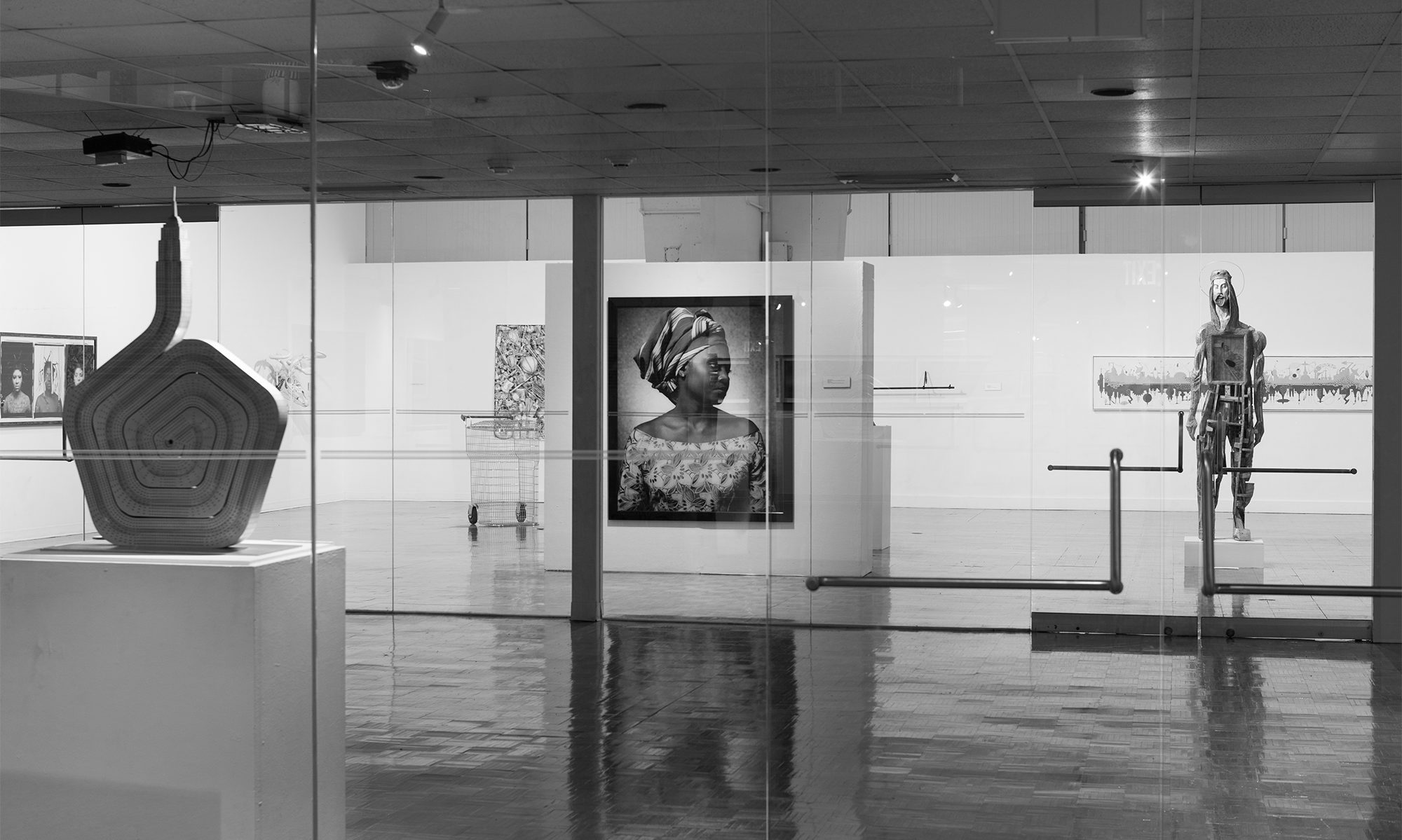
Lehman College Art Gallery
February 7 – May 6, 2017
Opening Reception: March 23, 2017 from 5 to 8PM
Lisa Alonzo | Hernan Bas | Suzette Bross | Patricia Cazorla | Jesse Chun | Richard Deon | Lalla Essaydi | Carla Gannis | Scherezade Garcia | Katy Grannan | Mona Hatoum | Meg Hitchcock | Alison Kuo | Cecilia Mandrile | Lothar Osterburg | Nancy Saleme | Nari Ward | Tricia Wright
This project is co-curated by Bartholomew Bland and Yuneikys Villalonga
All people today feel the impact of isolation within crowded communities, the absence of face-to-face communication, and the bytes and metadata of unbounded technology. Political upheavals around the globe spawn issues of dislocation and disappearing resources that crisscross countries and continents, and reach deeply into the psychology of the individual, stirring fear. Alien Nations at Lehman College Art Gallery explores the ways artists convey people’s feelings of alienation and, at times, their mental and physical separation from the societies to which they belong.
Artists often voice awareness of a troubling environment and in this exhibition 18 artists examine our sense of being “plugged in” to a technology- drenched society, where nonstop instant communication and thousands of online “friends” can fragment our identity and
make us uncertain about our place in a shifting world. In the pages that follow you see a broad range of media ― painting, photography, sculpture, installation, video, and performance documentation by emerging and established artists whose work shows people struggling in today’s social disorder. They combine diverse materials and intriguing ways and with a high degree of craft and concern for aesthetic beauty. Their powerful work, satirical, metaphorical, or personal, documents acute states of psychological anxiety and the despair of their subjects, as well as their own engagement with today’s social issues.
All the works in Alien Nations explore contemporary forms of alienation—be they personal or collective, self-in icted or enforced by others, drawn from real, historical models or from imagined creations. Nari Ward uses colorful, hand-dyed shoelaces in Angelic Troublemakers to comment on social protest in the nation’s conversation; Lalla Essaydi’s beautiful image in Bullet Revisited #26 is an ironic contrast to war’s violence.
Hernan Bas’s video, All By Myself, shows a man-who, isolated, retreats into self-pleasuring narcissim. Katy Grannan photographs glamorous, unnamed women whose faces are undercut with a sense of life’s despair.
The theme of the “faceless gure” that runs through Alien Nations appears in works by Carla Gannis, whose photographs show us the anxious psychological state. In Re(presented) Mar 25 [Block Head] and other prints, she pixilates the human face swamped out of existance by a sea of digital information. Cecilia Mandrile highlights the malleability of the self in One Other (The Desert Inside), as her faceless doll fruitlessly stares into a plate emblazoned with another staring face that cannot be seen or mirrored back. Likewise, Tricia Wright’s Late Mirror Stage monochromatic mirror paintings are incapable of re ecting the viewer, suggesting both the pointlessness of vanity and a profound abnegation of self. In her photography series Walk, Suzette Bross shows segmented, disembodied feet―sel es in which individual identity is swept away.
Several of the artists use images to show language can bring us feelings of disjointed isolation. Meg Hitchcock discourages us from reading her image Prayer Cloth #2 by ignoring unctuation and spacing in the sentences she forms. Our perception of being lost in translation, of meaning rendered meaningless, is echoed by Lothar Osterburg in City of Towers, prints that show prideful builders of a tower punished by suddenly speaking a myriad of languages, which renders them incomprehensible to one another.
With irony and humor, other artists ridicule military threats, vague or real. Mona Hatoum’s photograph Over My Dead Body shows her face in pro le, a tiny toy soldier sitting on her nose.
The artist’s angry, alienating glare makes war seem small and powerless, even something laughable . In the Gallery’s Rotunda, the four planes in Richard Deon’s The Quick Response Squadron, circle aimlessly, despite the crosshairs of bomb targets that line the wall. We intuit the ominous bomb blast, too, in Lisa Alonzo’s Waste/Repetition and Repetition/Waste that present the 2011 nuclear disaster at the Fukushima Power Plant, but her “bomb blast” rings incongruously look like the sugar roses that are piped onto a birthday cake.
Immigrating, seeking elusive opportunity in an unknown place, brings real dislocation and isolation that provides more matter for the artists. In DeFence, Patricia Cazorla and Nancy Saleme create a slatted fence, painting its surface with images of migrant laborers toiling in elds, their harvest, not for them, will be laid upon a dining table to be enjoyed by privileged others. Alison Kuo’s video Takeout Banquet looks at the immigrant experience with food from another perspective―working with fast food. In Theories of Freedom: Golden Landscape,
Scherezade Garcia paints inner tubes with cheering travel symbols, ironically speaking to the plight of desperate refugees voyaging to an unknown place on imsy rafts. Jesse Chun’s Blueprints #1-25 presents the ghostly outlines of immigration and passport applications that we instantly recognize as symbols of demanding bureaucracy.
The subjects of Alien Nations hearken back to the ancient, ironic Chinese curse, “May you live in interesting times.” Our times are turbulent, dangerous, and certainly interesting. The Lehman College Art Gallery recognizes that art has transformative power to promote awareness, provoke dialogue, and inspire action. Art has the power to shift public sentiment and begin conversations about our most pressing social issues. We hope the artists of Alien Nations create this conversation with our visitors and begin to unpack today’s moments of anxiety.
Bartholomew F. Bland, Executive Director, Lehman College Art Gallery
Yuneikys Villalonga, independent critic and curator
